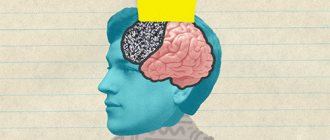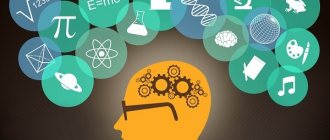Some people have good visual memory; it helps them remember large texts, phone numbers, poems, small details from a person they saw for two seconds. These are ordinary people, they just have a well-developed visual memory from birth.
A well-developed visual memory helps a person easily cope with memorizing a large stream of information that he sees.
According to psychologists, it happens that a person has only one type of memory developed - visual, auditory or olfactory.
A person on his life’s path must constantly remember something, and visual memory can be a great help to him.
How to develop visual memory if it is naturally underdeveloped?
Visual memory needs to be developed daily, this will require a little extra time, you can study in the evening, on a day off, on the way to work, during lunch break, while shopping, and so on.
Functions of visual memory
The main tasks of visual memory are fixing and remembering visual images for later use. The work of the PP can be considered using the example of recognizing a familiar face among other people. The action algorithm is as follows:
- visual perception of a face upon first meeting;
- placing the resulting image into long-term memory;
- visual perception of the face at the next meeting;
- comparing the picture with the one stored in memory.
How to develop memory in a child of preschool and school age
If there is a match, the person is familiar; if there is a mismatch, the person is not.
Attention! The brain region located in the back of the brain, the occipital lobe, is responsible for the brain.
The lobe of the brain responsible for the brain
Pay attention to details
When the brain is not faced with the task of remembering some elements of the picture it sees, it does not strain. To bring the ability to notice details to automaticity, you need to practice. What was the colleague you met on the street wearing? How did you gesture? What was the background like behind him - the street, the kiosks, the trees? How many and what did you notice? How are the items arranged? By training your brain in this way, you will quickly teach it to remember the situation and minor details of the events that happened to you. The main thing is not to let him “hack” by creating fictitious details - to avoid this, return to the place and compare the features of the surroundings with what you remember.
original source https://constructorus.ru/
Share on social networks
RќСЂР°РІРёС‚СЃСЏ
Where is it used?
How to develop a sense of humor - what it is and how it manifests itself
The very first candidate on the list who might benefit from a salary is a person involved in the fine arts. Painters and sculptors can draw a portrait from memory or sculpt it in clay.
A short list of professions where a good salary means a lot is as follows:
- Military personnel: scouts, sappers, miners, snipers - there is a need to remember the terrain, the location of objects and notice any change in the situation;
- Police officers, detectives, security guards - a mandatory memory for faces is required for recognition and identification;
- Drivers of vehicles must remember the route and the road picture as a whole;
- Foresters, rangers and hunters are required to be able to navigate the forest, distinguish between animals of the same breed, and distinguish trees from one another.
By the way. An experienced conductor, using visual memory, knows to whom he sold a ticket and to whom he did not.
Conductor and passenger
Photo scanning
There are human scanners for whom it is not difficult to extract information from an object, image, text by briefly looking at it. You can envy them, but it’s better to try to awaken this quality in yourself and your loved ones. Moreover, this is not an impossible task.
For example, there is such a simple exercise on how to develop this skill. Place several matches on the table, forming a certain figure or in a random order, chaotically. Let the subject look at this drawing, turn away, and then (after the desired “drawing” is already covered with a thick sheet of paper) try to reproduce the configuration.
Similar tasks can be given with color pictures: you will need to name the maximum number of the smallest details of the image. Or describe your toy or piece of clothing in great detail. If possible, try to draw a picture of the subject of your research.
Few people can boast of a photographic memory for faces ; this is truly a rare talent. Again, if nature has rested on you in this, make up for lost time by practicing memorization using the scanning method. Take any text, first catch with your eyes a couple of words that catch your eye, try to assimilate them. Then expand the “search territory” more and more to a line, phrase, paragraph - and so on. In a similar way, you can learn to take in different objects with your gaze.
Causes of poor memory
If a person has trouble remembering faces or gets confused in directions in the subway and underground passages, he may have problems with salary. It happens that a head injury in the back of the head leads to loss of visual memory. In addition, this includes such points as:
- deterioration of health with age;
- brain overload with excess information;
- lack of fatty acids in foods.
Logical thinking - what is it and how to develop it in an adult and a child
Smoking, drug addiction and alcoholism significantly reduce visual memory.
Important! Diseases associated with impaired brain activity can also lead to deterioration of mental health. For example, these include Parkinson's disease, Alzheimer's disease, stroke, and brain tumors.
Deterioration of visual memory
Child's memory
In the modern world, education plays a vital role. How well a person will receive it largely depends on the ability to productively assimilate the information received. Since we begin to learn from an early age, it is important to develop a child’s memory from childhood. There are several types of it:
- Visual. We most often use it to receive and remember data about the world around us. It is this that allows us to absorb large amounts of knowledge from books and electronic media. It is a fundamental factor for high-quality receipt and memorization of information in various disciplines of schools and universities.
- Auditory. The ability to perceive information by ear is available to us from early childhood. When a baby is born, he is not yet able to focus on surrounding objects, but he perfectly remembers the voices of loved ones. When a child grows up a little, it is thanks to hearing that he remembers the sounds that animals, nature, and transport make.
- Motor or motor. It allows a person to know how to correctly perform a particular physical action. We don’t think about it when we write in a notebook, since our muscles remember what movements must be followed to draw a particular sign. Thanks to this, we perform many actions mechanically, because they are honed and reinforced in practice.
- Olfactory, tactile and gustatory. These types of memory allow us to remember various pleasant and not so pleasant sensations: what a lilac smells like, what a watermelon tastes like, how painful it is if you prick yourself with a sewing needle. Thanks to such information, a person manages to exist safely in the world around him, avoid dangers and strive for his own comfort.
Types of visual memory
As the Chinese proverb says: “It is better to see once than to hear a thousand times.” Visual memorization can be classified according to the following parameters:
- duration of preservation and consolidation of the image;
- goal setting;
- way of remembering.
The duration of work with a memory image can be short-term or long-term. Short-term - implies only the fact of fixation, and long-term - fixing the picture in memory for a long time.
There are two types of target setting:
- deliberate - when special methods are used to achieve the goal of remembering something;
- unintentional - there is no specific goal to remember, and the fixation of images occurs without additional effort.
Proven. Remembering what a picture of a complex formula looks like (its entire visual appearance) is easier than remembering its detailed writing.
Certain types of salary
Features of visual memory
Scientists identify the following features of the salary for various moments:
- gender;
- age;
Upon closer examination, each species can reveal its own distinctive features.
Gender
Considering the level of development of visual memory by gender, experts noted that it is higher in girls. Obviously, this is due to the fact that they have a very rich imagination. They actively use images: they dress up dolls, play “shop”, “shopping”, “dress up”. Boys are fond of outdoor games. Subsequently, the girl, having turned into a woman, continues to notice every little thing. Men tend to look at the image as a whole.
Age
The psychology of children and adolescents at a certain stage of development allows us to observe eidetic memory in them.
Attention! This is one of the varieties of vision, which is the ability to see an object after it is no longer in sight.
This age-related phenomenon allows the owner to see a previously seen picture on a blank sheet of paper and can be either obvious or hidden. In the first case, a really non-existent picture is observed with open eyes, in the second, to do this you need to close your eyes and concentrate. Sometimes an adult is endowed with such abilities.
Figurative memory
Distributing this method of memorization according to the degree of maturation, the following phases are distinguished:
- Preschool (maximum) – changes in the structure of the eyes occur, the importance of tactile sensations decreases, and mobility increases in children 3-4 years old. They visually record the entire object; at 5-6 years old, a preschooler can already, while looking at an object, note individual details in memory;
- Junior schoolchild (voluntary) - the volume of learning increases due to the task being set for the child to learn something by heart, conscious work with visualization occurs;
- Teenage (delayed) - work with visual images is relegated to second place by logic, thinking determines the purpose of visualization and its feasibility;
- Adult – at this age, the functioning of visual memory directly depends on life style and profession.
Interesting. The volume of visual memory among lovers of an active lifestyle is several times higher than that of homebodies. This is due to the large amount of incoming visual information that can be stored, both unintentionally and intentionally.
Eidetic memory in childhood and adulthood
Memory is a link connecting the past and the present, helping not to lose touch with the roots. Knowing how to train visual memory is extremely important, since it is one of the levers for the development of humanity.
Otherwise, this type of memorization is called eidetic, and there are also other varieties:
- Auditory;
- Motor;
- Olfactory;
- Tactile.
They can be short-term or long-term, mechanical or sensory. For each individual type, different development methods are provided; they are also available for improving eidetic memory.
It is known that in children it is quite sharp and durable, but over the years the ability to imprint the surroundings on the brain is lost in a person. And in adulthood, only a few who were lucky enough to receive such a gift from nature, from their parents, can boast of such skills.
What should the rest of us do? Don’t despair, don’t be lazy, remember a simple rule: any skill can be acquired through repeated exercises and training. And then we will be able not to strain too much, “driving” certain information into our heads, but to assimilate it “wholesale”, just by looking at the image or text.
Only specialists know what exactly is triggered in the brain, but in fact, subjectively, everything remembered is reproduced as a video, and without effort, by itself. These stories are especially vivid when other types of memory are included in the process, then they work together and give maximum effect, complementing each other.
Diagnostic methods
You can determine whether visual memory is bad or good using tests. They are carried out independently or entrusted to a psychologist. The basis of any tests are pictures. Emphasis is placed on the number of drawn objects, their location and small details. A simple exercise to do with an assistant:
- lay out 10 small objects on the table;
- within one minute carefully remember them;
- after which, they close their eyes, and the assistant removes one of the objects and changes the location of the remaining ones.
The test taker must open his eyes and say which item is missing.
How to develop visual memory
If tests show a low ability to remember a briefly seen picture, then how to develop visual memory? There are ways to improve it.
A person can improve visual memory by doing exercises like:
- solving rebuses, puzzles and finding differences in drawings - such games are useful at any age;
- splitting the image into details - memorizing individual fragments after visual separation allows you to quickly fix the entire image in memory;
- verbal expression of the image - when breaking down the image, you can describe each fragment in detail in words; words recorded in a certain order will help you remember the image;
- development of synesthetic perception - linking visual pictures with the senses, creating associations: red color - sweet taste, blue color - smells like the sea, hedgehog - prickly to the touch, etc.
ZP at any age is an excellent assistant for movement, communication and creativity. It is indispensable in everyday life; full development of personality is impossible without visual memory, so it is imperative to train it.
Roman room method
This method, also called the Cicero chain, is a very effective way to teach how to structure information for better memorization. The bottom line is this: the objects to be remembered must be mentally placed in a well-known room (for example, in your room), but in a strictly defined order. And then later, in order to reproduce the necessary information, you will need to remember this room.
Allegedly, this is exactly what Cicero, a famous Roman thinker and orator, did before his speech. As he walked through his home, he placed the most important points of his speech in familiar or favorite corners. And while giving a speech, it was as if I was walking along this route again, remembering the key moments. You can, of course, use not only a room or a house as such a “storage,” but also the street, a closet, or even your desk, as long as these objects are well known for remembering these very “nooks and crannies.”











